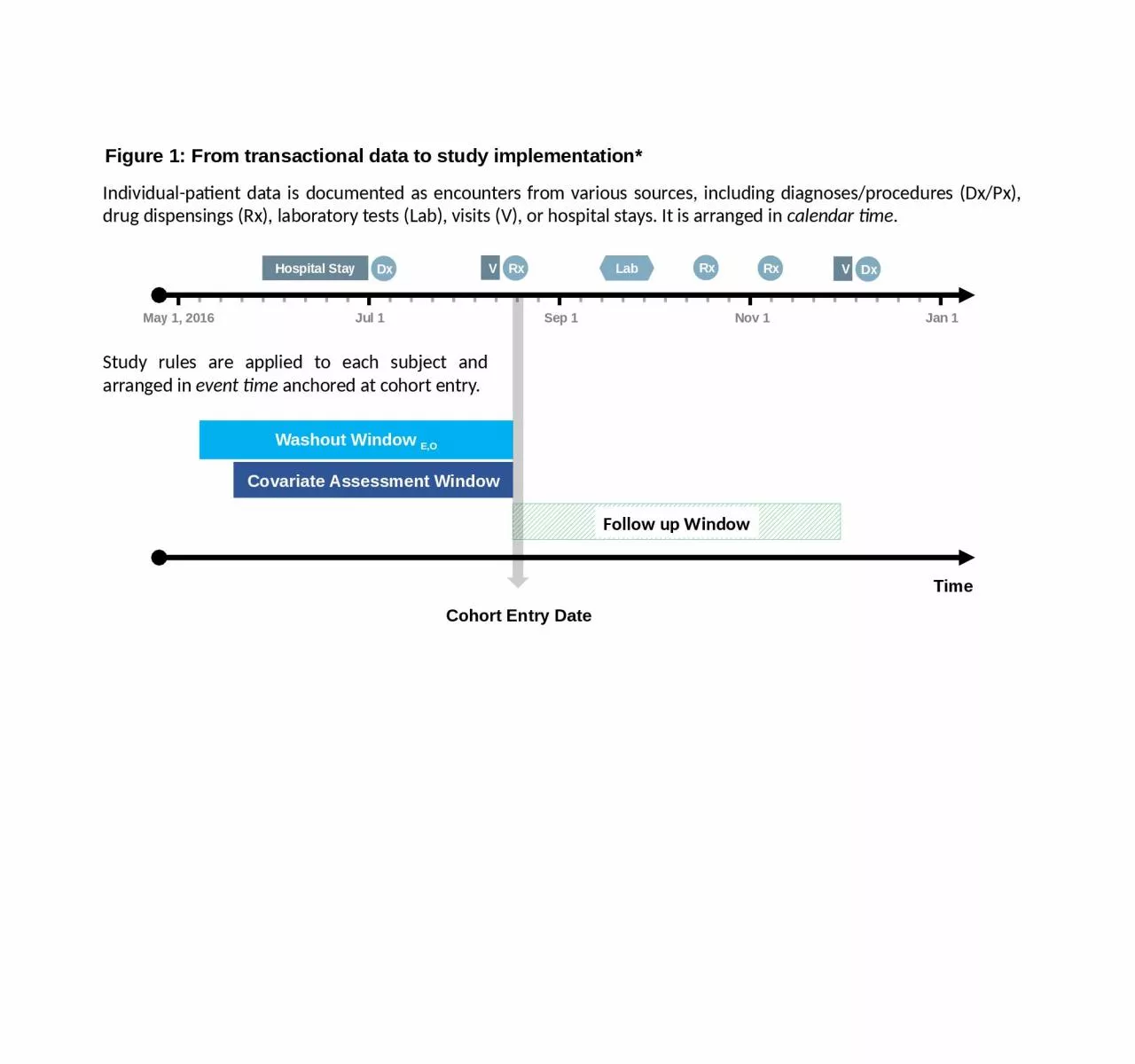

Cohort Entry Date May 1 2016 Jul 1 Sep 1 Nov 1 Jan 1 Hospital Stay Followup Window Dx V Rx Lab Rx Rx V Dx Figure 1 From transactional data to study implementation Individualpatient data is documented as encounters from various sources including diagnosesprocedures Dx ID: 1036012
Download Presentation The PPT/PDF document "Washout Window E,O Covariate Assessment..." is the property of its rightful owner. Permission is granted to download and print the materials on this web site for personal, non-commercial use only, and to display it on your personal computer provided you do not modify the materials and that you retain all copyright notices contained in the materials. By downloading content from our website, you accept the terms of this agreement.
1. Washout Window E,OCovariate Assessment WindowCohort Entry DateMay 1, 2016Jul 1Sep 1Nov 1Jan 1Hospital StayFollow-up WindowDxVRxLabRxRxVDxFigure 1: From transactional data to study implementation*Individual-patient data is documented as encounters from various sources, including diagnoses/procedures (Dx/Px), drug dispensings (Rx), laboratory tests (Lab), visits (V), or hospital stays. It is arranged in calendar time.Study rules are applied to each subject and arranged in event time anchored at cohort entry.TimeFollow up Window
2. Follow-up WindowDays [0, Censorc]Exclusion Assessment Window(Intermittent medical and drug coveragea)Days [-183, -1]Covariate Assessment Window(Baseline conditionsb)Days [-183, -1]Cohort Entry Date(First prescription of ACE or ARB)Day 0Figure 2. Exposure-based cohort entry where the cohort entry date is selected prior to application of exclusion criteriaExclusion Assessment Window(Age ≤ 18, initiate both ACE and ARB)Days [0, 0]TimeWashout Window (exposure, outcome)(No ACE, ARB, Angioedema)Days [-183, -1]Up to 45 day gaps in medical or pharmacy enrollment allowedBaseline conditions included: allergic reactions, diabetes, heart failure, ischemic heart disease, non-steroidal anti-inflammatory drugsEarliest of: outcome of interest (angioedema), switching or discontinuation of study drugs, death, disenrollment, 365 days of follow-up, end of the study periodACE = angiotensin converting enzyme inhibitorARB = angiotensin II receptor blockersCovariate Assessment Window(Age, sex)Days [0, 0]Follow up WindowDays [0, Censorc]
3. Exclusion Assessment Window(Intermittent medical and drug coverageb)Days [-183, -1]Covariate Assessment Window(Baseline conditionsc)Days [-183, -1]Cohort Entry DateFirst prescription of ACE or ARB in a treatment episodeaDay 0Figure 3. Exposure-based cohort entry where the cohort entry date is selected after application of exclusion criteriaExclusion Assessment Window(Age ≤ 18, initiate both ACE and ARB)Days [0, 0]TimeWashout Window (exposure, outcome)(No ACE, ARB, Angioedema)Days [-183, -1]Treatment episodes defined by date of dispensation and days supply with a stockpiling algorithm if a new dispensation occurs before the end of days supply. Gaps of less than 30 days between end of days supply and next dispensation were bridged. Thirty days was added to the last dispensation’s days supply in an exposure episode. Up to 45 day gaps in medical or pharmacy enrollment allowedBaseline conditions included: allergic reactions, diabetes, heart failure, ischemic heart disease, non-steroidal anti-inflammatory drugsEarliest of: outcome of interest (angioedema), switching or discontinuation of study drugs, death, disenrollment, 365 days of follow-up, end of the study periodACE = angiotensin converting enzyme inhibitorARB = angiotensin II receptor blockersCovariate Assessment Window(Age, sex)Days [0, 0]Keep first qualifying new initiator episode observed within study period for each patientFollow-up WindowDays [0, Censord]Follow up WindowDays [0, Censord]
4. Exposure Assessment WindowDays [0, 180]Exclusion Assessment Window (EXCL)(Intermittent medical and drug coverage,baseline conditionsa,b)Days [-365, -1]Covariate Assessment Window(Baseline conditionsc)Days [-365, -1]Cohort Entry Date(Initiation of statin or glaucoma Rx)Day 0Figure 4. Exposure-based cohort entry restricted to adherent usersEXCL(Age ≤ 65, initiate statin and glaucoma Rx)Days [0, 0]TimeWashout Window(No exposure to statin, glaucoma Rx)Days [-365, -1]EXCL(CVD conditions)Days [-183, -1]Follow-up WindowDays [3rd refill, Censor]Excluded if evidence of: dementia, cancer. Excluded if no evidence for at least one of the following conditions: angina, intermittent claudication, hypertension, diabetes, history of stroke, transient ischemic attack, myocardial infarction, arterial surgery, amputation for vascular disease, or smoking Full list and code algorithms provided in the published paper’s appendixCensored at earliest of outcome, death, disenrollment or end of the study periodCovariate Assessment Window(Age, sex)Days [0, 0]Follow up WindowDays [3rd refill, Censord]
5. Follow-up WindowDays ([0, Censor]Exposure Assessment Window(Ever pioglitazone or rosiglitazone)[0, ED – 365]Exclusion Assessment Window (EXCL)(History of bladder cancer)Days [-∞, -1]Covariate Assessment Window(Baseline conditions)Days [-∞, -1]Cohort Entry Date(Initiation of any antidiabetic)Day 0Figure 5. Visualizing a nested case-control design with risk-set samplingEXCL(Age < 40, Prescribed insulin)Days [0, 0]TimeWashout Window(No oral antidiabetic agents)Days [-∞, -1]EXCL(>1 year medical history)Days [-365, -1]Event Dateb(ED)EXCL(<1 year between cohort entry and event date)Days [0, 365]Covariate Assessment Window(Age, sex)Days [ED, ED]Follow up WindowDays [0, Censora]Censored at minimum of incident bladder cancer, death, disenrollment or end of the study periodControls risk-set matched on year of cohort entry, duration of follow up (from cohort entry), age and sex
6. Follow-up WindowDays ([0, 365]Exclusion Assessment Window(Died)Days [-365, -1]Covariate Assessment Window(Predictors of mortalitya, comorbidityb)Days [-365, -1]Cohort Entry Date(January 1, 2005)Day 0E-Figure 1. Time-based cohort entry TimeExclusion Assessment Window(No pharmacy claim)Days [-485, -365]Exclusion Assessment Window(Age ≤ 65)Days [0, 0]Predictors of mortality included 17 conditions included in Romano’s adaptation of the Charlson Index, 30 conditions included in the Elixhauser score (details in appendix)Other comorbidities measured included: hospitalization, use of any prescription drug, receipt of any diagnosis, any physician visit, any time in a nursing home, number of hospital days, number of distinct prescription drugs used, number of diagnoses, and number of physician visits Follow up WindowDays [0, 365]
7. Exclusion Assessment Window(>3 years of medical history in data source)Days [-1095, -1]Washout Window(Exposure effects)Days [-364, -12]Event Date(Myocardial Infarction)Day 0Exclusion Assessment Window(Age ≤ 75)Days [0, 0]TimeWashout Window(Outcome – myocardial infarction)Days [-∞, -1]E-Figure 2. An outcome-indexed self-controlled design (case-crossover)Exposure Assessment Window(Acute Resp. Infection)Days [-376, -365]Exposure Assessment Window(Acute Resp. Infection)Days [-11, -1]
8. Washout Window(Exposure)Days [-56, -1]Cohort Entry Date(Vaccination)Day 0EXCL(Age < 11 or Age > 23 [months])Days [0, 0]TimeE-Figure 3. An exposure indexed self-controlled design (self-controlled risk interval) Washout Window(Outcome)Days [ED-56, ED-1]Event Date (ED)(seizure) Follow Up Window (Hypothesized exposure risk window)Days [7, 10]Washout Window(Effects of exposure)Days [11, 13] Follow Up Window (Reference window)Days [14, 56]Exclusion Assessment Window(if vaccine and seizure do not occur within 56 days)Days [1, 56]